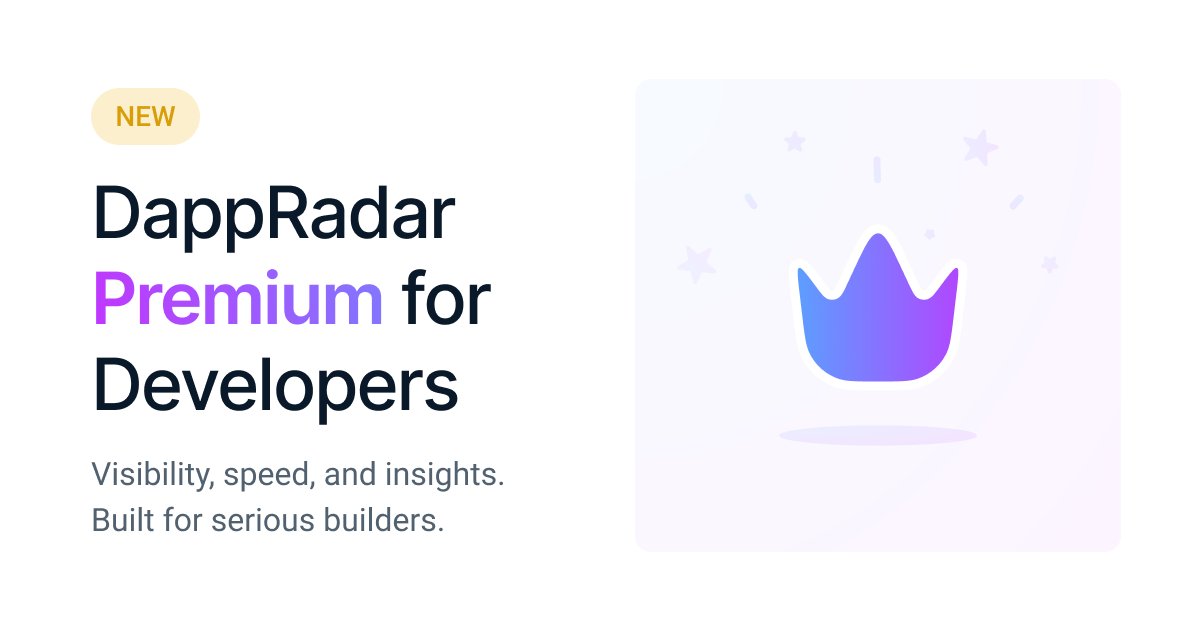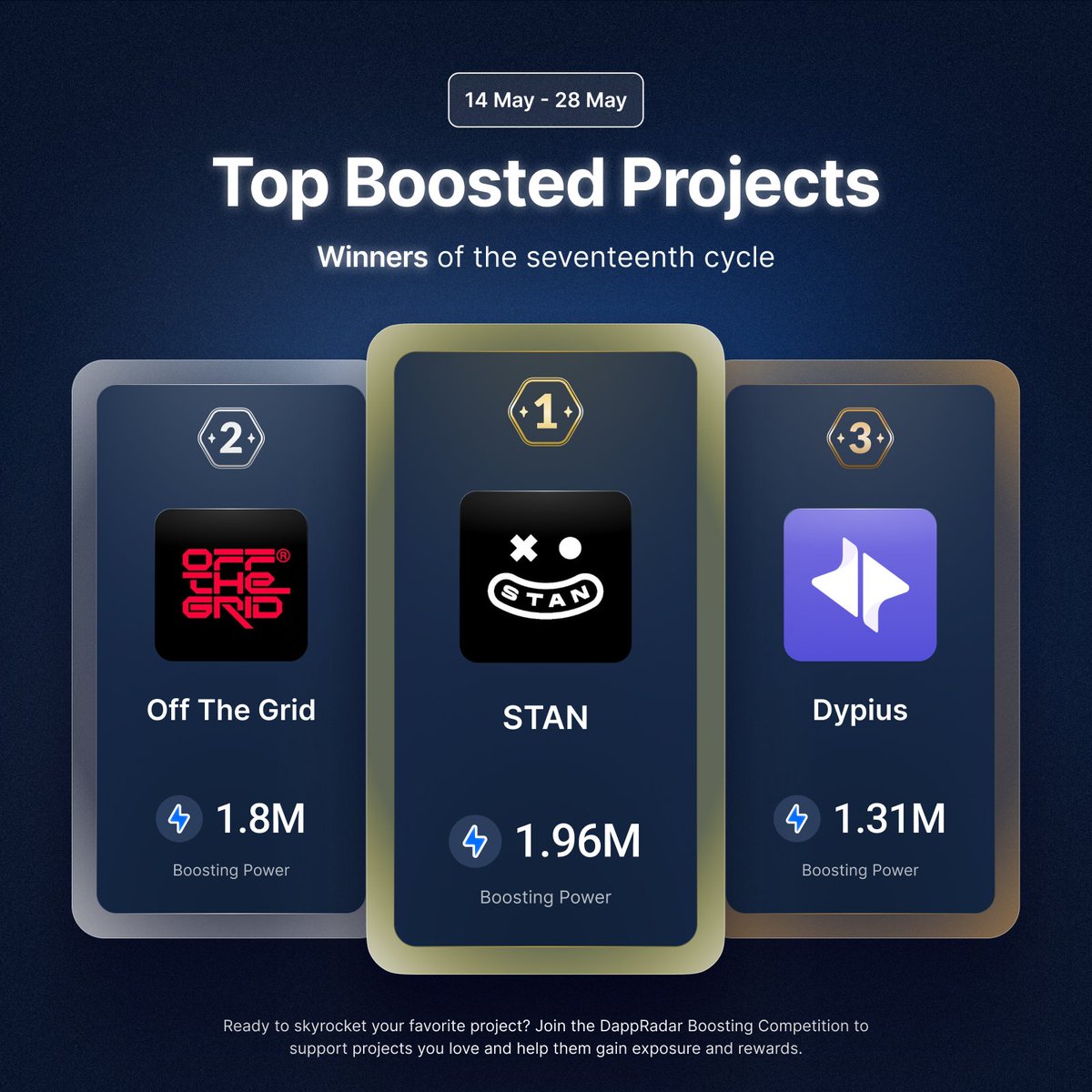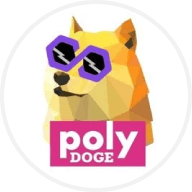
RADAR
Ціна DappRadar
$0,0033920
-$0,00019
(-5,31%)
Зміна ціни за останні 24 години

Який ваш сьогоднішній прогноз щодо RADAR?
Поділіться тут своїми настроями, поставивши великий палець угору, якщо передбачаєте підйом монети (бичачу поведінку), або великий палець униз, якщо передбачаєте спад (ведмежу).
Голосуйте, щоб переглянути результати
Застереження
Соціальний вміст на цій сторінці (далі — «Вміст»), зокрема твіти й статистика від LunarCrush, надається третіми сторонами на умовах «як є» виключно з інформаційною метою. Компанія OKX не гарантує якість або точність Вмісту, який не відображає її погляди. Він не має розцінюватися як (i) інвестиційна порада чи рекомендація; (ii) пропозиція або заохочення купувати, продавати чи утримувати цифрові активи; (iii) фінансова, бухгалтерська, юридична чи податкова консультація. Цифрові активи, зокрема стейблкоїни й NFT, пов’язані з високим ступенем ризику, а їх вартість може сильно коливатися. Ціна й показники ефективності цифрових активів не гарантуються та можуть змінюватися без попередження.
OKX не надає рекомендацій щодо інвестицій або активів. Ви повинні ретельно зважити, чи підходить вам торгувати цифровими активами чи утримувати їх, з огляду на свій фінансовий стан. Щодо ваших конкретних обставин порадьтеся з юридичним, податковим чи інвестиційним фахівцем. Щоб дізнатися більше, перегляньте наші Умови використання й Попередження про ризики. Використовуючи вебсайт третьої сторони (далі — «Сторонній вебсайт»), ви погоджуєтеся, що будь-яке використання Стороннього вебсайту регулюється умовами Стороннього вебсайту. Якщо це прямо не зазначено в письмовій формі, компанія OKX і її партнери (далі — OKX) жодним чином не пов’язані з власником або оператором Стороннього вебсайту. Ви погоджуєтеся, що OKX не несе відповідальності за жодні втрати, збитки й інші наслідки, що виникають у результаті вашого використання Стороннього вебсайту. Зверніть увагу, що використання Стороннього вебсайту може призвести до втрати або скорочення ваших активів. У деяких юрисдикціях продукт може бути недоступний.
OKX не надає рекомендацій щодо інвестицій або активів. Ви повинні ретельно зважити, чи підходить вам торгувати цифровими активами чи утримувати їх, з огляду на свій фінансовий стан. Щодо ваших конкретних обставин порадьтеся з юридичним, податковим чи інвестиційним фахівцем. Щоб дізнатися більше, перегляньте наші Умови використання й Попередження про ризики. Використовуючи вебсайт третьої сторони (далі — «Сторонній вебсайт»), ви погоджуєтеся, що будь-яке використання Стороннього вебсайту регулюється умовами Стороннього вебсайту. Якщо це прямо не зазначено в письмовій формі, компанія OKX і її партнери (далі — OKX) жодним чином не пов’язані з власником або оператором Стороннього вебсайту. Ви погоджуєтеся, що OKX не несе відповідальності за жодні втрати, збитки й інші наслідки, що виникають у результаті вашого використання Стороннього вебсайту. Зверніть увагу, що використання Стороннього вебсайту може призвести до втрати або скорочення ваших активів. У деяких юрисдикціях продукт може бути недоступний.
Інформація про ринок DappRadar
Ринкова капіталізація
Ринкова капіталізація обчислюється множенням циркулюючої пропозиції монети на останню ціну.
Ринкова капіталізація = циркулююча пропозиція × остання ціна
Ринкова капіталізація = циркулююча пропозиція × остання ціна
Циркулююча пропозиція
Загальна кількість монет, яка є на ринку у відкритому доступі.
Рейтинг ринкової капіталізації
Рейтинг монети з точки зору показника ринкової капіталізації.
Макс. за весь час
Найвища ціна, якої досягла монета за всю історію торгівлі.
Мін. за весь час
Найнижча ціна, яку мала монета за всю історію торгівлі.
Ринкова капіталізація
$5,05M
Циркулююча пропозиція
1 489 575 700 RADAR
14,89% з
10 000 000 000 RADAR
Рейтинг ринкової капіталізації
--
Аудити

Останній аудит: 31 лип. 2022 р., (UTC+8)
Макс. за 24 г
$0,0035820
Мін. за 24 г
$0,0032690
Макс. за весь час
$0,050000
-93,22% (-$0,04661)
Останнє оновлення: 22 лют. 2023 р., (UTC+8)
Мін. за весь час
$0,0023470
+44,52% (+$0,0010450)
Останнє оновлення: 7 квіт. 2025 р., (UTC+8)
DappRadar — новини
Наведений нижче вміст отримано з .

DappRadar
Ми щойно інтегрували @SubHubStack на DappRadar - тепер з історичними даними!
SubHub, створений компанією @Dmailofficial, — це інструмент обміну повідомленнями та маркетингу для проєктів Web3, який наразі є одним із найефективніших децентралізованих додатків на інтернет-комп'ютері @dfinity.
Показати оригінал
32,92 тис.
94

Skirmantas Januškas 📡
Трекер ринку OTG привернув величезну увагу завдяки виділенню KPI для конкретного проєкту, які йдуть глибше, ніж UAW
Відтепер ми в @DappRadar будемо пропонувати більш глибоку аналітику для web3 проєктів
Тисячі користувачів, інвесторів і журналістів щодня відвідують DappRadar
Перше враження має значення – покажіть їм, що ви отримали, за допомогою спеціальних діаграм і KPI, які підкреслюють ваші сильні сторони
Дізнайтеся більше про DappRadar Premium для розробників 👇

DappRadar
📣 Новинка: DappRadar Premium для розробників запущено!
Ми представляємо підписку для розробників, які хочуть краще контролювати те, як їхній проєкт відображається, працює та розвивається на DappRadar.
Доступно на рівні проекту, для всіх розробників.
Дізнайтеся, що включено 👇

12 тис.
25

DappRadar
📣 Новинка: DappRadar Premium для розробників запущено!
Ми представляємо підписку для розробників, які хочуть краще контролювати те, як їхній проєкт відображається, працює та розвивається на DappRadar.
Доступно на рівні проекту, для всіх розробників.
Дізнайтеся, що включено 👇
Показати оригінал
22,06 тис.
60

DappRadar
Кредитування NFT сильно 🧐 охололо
Обсяг знизився на 94% порівняно з 1 мільярдом доларів ATH у січні 2024 року. Але під поверхнею є ще дещо. З'являються нові лідери, і сектор може розвиватися, а не вмирати.
Прочитайте повний звіт або ознайомтеся з ключовими моментами нижче 👇
Показати оригінал17,72 тис.
25
Калькулятор RADAR


Показники ціни DappRadar у USD
Поточна ціна DappRadar становить $0,0033920. За останні 24 години для DappRadar спостерігалося зменшується на -5,30%. Наразі циркулююча пропозиція становить 1 489 575 700 RADAR, а максимальна — 10 000 000 000 RADAR, що дає повністю розбавлену ринкову капіталізацію в розмірі $5,05M. На сьогодні монета DappRadar займає 0 позицію в рейтингу ринкової капіталізації. Ціна DappRadar/USD оновлюється в режимі реального часу.
Сьогодні
-$0,00019
-5,31%
7 днів
-$0,00036
-9,62%
30 днів
+$0,00073000
+27,42%
3 місяці
-$0,00062
-15,50%
Популярні конвертації DappRadar
Останнє оновлення: 31.05.2025, 05:20
| 1 RADAR у USD | 0,0033930 $ |
| 1 RADAR у EUR | 0,0029878 € |
| 1 RADAR у PHP | 0,18936 ₱ |
| 1 RADAR у IDR | 55,5047 Rp |
| 1 RADAR у GBP | 0,0025184 £ |
| 1 RADAR у CAD | 0,0046570 $ |
| 1 RADAR у AED | 0,012462 AED |
| 1 RADAR у VND | 88,2904 ₫ |
Про DappRadar (RADAR)
Рейтинг визначено на основі даних, зібраних OKX із наданих джерел, і має виключно інформаційний характер. OKX не гарантує якість або точність рейтингів. Вони не призначені для надання (i) інвестиційних порад або рекомендацій; (ii) пропозиції або заохочення купувати, продавати чи утримувати цифрові активи; або (iii) фінансових, бухгалтерських, юридичних або податкових консультацій. Вартість цифрових активів, включаючи стейблкоіни й NFT, пов’язана з високим ризиком і може сильно коливатися й навіть знецінюватися. На цифрові активи не поширюються жодні гарантії, і їх можуть змінити без попереднього сповіщення. Ваші цифрові активи не застраховані від можливих збитків. Прибутковість в минулому не гарантує аналогічних прибутків у майбутньому. OKX не гарантує повернення інвестованого капіталу чи відсотки з нього. OKX не надає рекомендацій щодо інвестицій або активів. Ви маєте самостійно вирішувати, чи варто торгувати цифровими активами або утримувати їх, зважаючи на свій фінансовий стан. Якщо у вас виникнуть запитання, проконсультуйтеся з юридичним/податковим/інвестиційним фахівцем.
Показати більше
- Офіційний вебсайт
- Whitepaper
- Оглядач блоків
Про сторонні вебсайти
Про сторонні вебсайти
Використовуючи вебсайт третьої сторони (далі — «Сторонній вебсайт»), ви погоджуєтеся, що будь-яке використання Стороннього вебсайту регулюється умовами Стороннього вебсайту. Якщо це прямо не зазначено в письмовій формі, OKX і партнери компанії (далі — «OKX») жодним чином не пов’язані з власником або оператором Стороннього вебсайту. Ви погоджуєтеся, що OKX не несе відповідальності за жодні втрати, збитки й інші наслідки, що виникають у результаті використання вами Стороннього вебсайту. Зверніть увагу, що використання Стороннього вебсайту може призвести до втрати або зменшення ваших активів.
DappRadar — FAQ
Що таке DappRadar?
DappRadar – це провідна платформа, яка надає точні ринкові дані та цінну інформацію про ринок децентралізованих програм (dApp). Вона дозволяє користувачам безперешкодно відстежувати рух ринку та бути в курсі останніх тенденцій і розробок.
Яка користь і переваги від володіння RADAR?
Володіння токенами RADAR пропонує ряд переваг. Власники токенів RADAR мають можливість отримувати винагороди та доступ до функцій відстеження програм і даних, що пропонуються платформою. Крім того, володіння токенами RADAR надає право голосу, що дозволяє власникам брати активну участь в управлінні та процесах прийняття рішень спільнотою DappRadar.
Де можна придбати RADAR?
Ви можете легко купити токени RADAR на криптовалютній платформі OKX. Термінал спотової торгівлі OKX пропонує торгову пару RADAR/USDT.
Скільки сьогодні коштує 1 DappRadar?
Наразі один DappRadar коштує $0,0033920. Якщо вам цікава динаміка цін DappRadar — ви потрапили в потрібне місце. Слідкуйте за графіками DappRadar і торгуйте відповідально з OKX.
Що таке криптовалюта?
Криптовалюти, як-от DappRadar, є цифровими активами, які працюють на основі публічного реєстру, що називається блокчейн. Дізнайтеся більше про монети й токени на OKX і їх атрибути, зокрема ціни та графіки в режимі реального часу.
Коли була винайдена криптовалюта?
Через фінансову кризу 2008 року інтерес до децентралізованих фінансів різко зріс. Bitcoin став новим безпечним цифровим активом у децентралізованій мережі. З того часу було створено багато інших токенів, як-от DappRadar.
Чи зросте сьогодні ціна на DappRadar?
Перегляньте сторінка з прогнозами цін на DappRadar, щоб передбачати майбутні ціни й визначати цільову вартість.
Розкриття інформації про ESG
Принципи екологічного, соціального й корпоративного управління (Environmental, Social, and Governance, ESG) для криптовалютних активів покликані вирішити проблеми, пов’язані з їх впливом на довкілля (наприклад, енергозатратний майнінг), сприяти прозорості й забезпечувати етичні методи управління, щоб узгодити криптовалютну галузь із більш масштабними цілями сталого розвитку й суспільства. Ці принципи заохочують дотримуватися стандартів, що знижують ризики й зміцнюють довіру у сфері цифрових активів.
Відомості про актив
Назва
OKcoin Europe LTD
Ідентифікатор відповідної юридичної особи
54930069NLWEIGLHXU42
Назва криптовалютного активу
dapp_radar
Механізм консенсусу
dapp_radar is present on the following networks: Binance Smart Chain, Ethereum, Polygon.
Binance Smart Chain (BSC) uses a hybrid consensus mechanism called Proof of Staked Authority (PoSA), which combines elements of Delegated Proof of Stake (DPoS) and Proof of Authority (PoA). This method ensures fast block times and low fees while maintaining a level of decentralization and security. Core Components 1. Validators (so-called “Cabinet Members”): Validators on BSC are responsible for producing new blocks, validating transactions, and maintaining the network’s security. To become a validator, an entity must stake a significant amount of BNB (Binance Coin). Validators are selected through staking and voting by token holders. There are 21 active validators at any given time, rotating to ensure decentralization and security. 2. Delegators: Token holders who do not wish to run validator nodes can delegate their BNB tokens to validators. This delegation helps validators increase their stake and improves their chances of being selected to produce blocks. Delegators earn a share of the rewards that validators receive, incentivizing broad participation in network security. 3. Candidates: Candidates are nodes that have staked the required amount of BNB and are in the pool waiting to become validators. They are essentially potential validators who are not currently active but can be elected to the validator set through community voting. Candidates play a crucial role in ensuring there is always a sufficient pool of nodes ready to take on validation tasks, thus maintaining network resilience and decentralization. Consensus Process 4. Validator Selection: Validators are chosen based on the amount of BNB staked and votes received from delegators. The more BNB staked and votes received, the higher the chance of being selected to validate transactions and produce new blocks. The selection process involves both the current validators and the pool of candidates, ensuring a dynamic and secure rotation of nodes. 5. Block Production: The selected validators take turns producing blocks in a PoA-like manner, ensuring that blocks are generated quickly and efficiently. Validators validate transactions, add them to new blocks, and broadcast these blocks to the network. 6. Transaction Finality: BSC achieves fast block times of around 3 seconds and quick transaction finality. This is achieved through the efficient PoSA mechanism that allows validators to rapidly reach consensus. Security and Economic Incentives 7. Staking: Validators are required to stake a substantial amount of BNB, which acts as collateral to ensure their honest behavior. This staked amount can be slashed if validators act maliciously. Staking incentivizes validators to act in the network's best interest to avoid losing their staked BNB. 8. Delegation and Rewards: Delegators earn rewards proportional to their stake in validators. This incentivizes them to choose reliable validators and participate in the network’s security. Validators and delegators share transaction fees as rewards, which provides continuous economic incentives to maintain network security and performance. 9. Transaction Fees: BSC employs low transaction fees, paid in BNB, making it cost-effective for users. These fees are collected by validators as part of their rewards, further incentivizing them to validate transactions accurately and efficiently.
The crypto-asset's Proof-of-Stake (PoS) consensus mechanism, introduced with The Merge in 2022, replaces mining with validator staking. Validators must stake at least 32 ETH every block a validator is randomly chosen to propose the next block. Once proposed the other validators verify the blocks integrity. The network operates on a slot and epoch system, where a new block is proposed every 12 seconds, and finalization occurs after two epochs (~12.8 minutes) using Casper-FFG. The Beacon Chain coordinates validators, while the fork-choice rule (LMD-GHOST) ensures the chain follows the heaviest accumulated validator votes. Validators earn rewards for proposing and verifying blocks, but face slashing for malicious behavior or inactivity. PoS aims to improve energy efficiency, security, and scalability, with future upgrades like Proto-Danksharding enhancing transaction efficiency.
Polygon, formerly known as Matic Network, is a Layer 2 scaling solution for Ethereum that employs a hybrid consensus mechanism. Here’s a detailed explanation of how Polygon achieves consensus: Core Concepts 1. Proof of Stake (PoS): Validator Selection: Validators on the Polygon network are selected based on the number of MATIC tokens they have staked. The more tokens staked, the higher the chance of being selected to validate transactions and produce new blocks. Delegation: Token holders who do not wish to run a validator node can delegate their MATIC tokens to validators. Delegators share in the rewards earned by validators. 2. Plasma Chains: Off-Chain Scaling: Plasma is a framework for creating child chains that operate alongside the main Ethereum chain. These child chains can process transactions off-chain and submit only the final state to the Ethereum main chain, significantly increasing throughput and reducing congestion. Fraud Proofs: Plasma uses a fraud-proof mechanism to ensure the security of off-chain transactions. If a fraudulent transaction is detected, it can be challenged and reverted. Consensus Process 3. Transaction Validation: Transactions are first validated by validators who have staked MATIC tokens. These validators confirm the validity of transactions and include them in blocks. 4. Block Production: Proposing and Voting: Validators propose new blocks based on their staked tokens and participate in a voting process to reach consensus on the next block. The block with the majority of votes is added to the blockchain. Checkpointing: Polygon uses periodic checkpointing, where snapshots of the Polygon sidechain are submitted to the Ethereum main chain. This process ensures the security and finality of transactions on the Polygon network. 5. Plasma Framework: Child Chains: Transactions can be processed on child chains created using the Plasma framework. These transactions are validated off-chain and only the final state is submitted to the Ethereum main chain. Fraud Proofs: If a fraudulent transaction occurs, it can be challenged within a certain period using fraud proofs. This mechanism ensures the integrity of off-chain transactions. Security and Economic Incentives 6. Incentives for Validators: Staking Rewards: Validators earn rewards for staking MATIC tokens and participating in the consensus process. These rewards are distributed in MATIC tokens and are proportional to the amount staked and the performance of the validator. Transaction Fees: Validators also earn a portion of the transaction fees paid by users. This provides an additional financial incentive to maintain the network’s integrity and efficiency. 7. Delegation: Shared Rewards: Delegators earn a share of the rewards earned by the validators they delegate to. This encourages more token holders to participate in securing the network by choosing reliable validators. 8. Economic Security: Slashing: Validators can be penalized for malicious behavior or failure to perform their duties. This penalty, known as slashing, involves the loss of a portion of their staked tokens, ensuring that validators act in the best interest of the network.
Механізми заохочення й відповідні комісії
dapp_radar is present on the following networks: Binance Smart Chain, Ethereum, Polygon.
Binance Smart Chain (BSC) uses the Proof of Staked Authority (PoSA) consensus mechanism to ensure network security and incentivize participation from validators and delegators. Incentive Mechanisms 1. Validators: Staking Rewards: Validators must stake a significant amount of BNB to participate in the consensus process. They earn rewards in the form of transaction fees and block rewards. Selection Process: Validators are selected based on the amount of BNB staked and the votes received from delegators. The more BNB staked and votes received, the higher the chances of being selected to validate transactions and produce new blocks. 2. Delegators: Delegated Staking: Token holders can delegate their BNB to validators. This delegation increases the validator's total stake and improves their chances of being selected to produce blocks. Shared Rewards: Delegators earn a portion of the rewards that validators receive. This incentivizes token holders to participate in the network’s security and decentralization by choosing reliable validators. 3. Candidates: Pool of Potential Validators: Candidates are nodes that have staked the required amount of BNB and are waiting to become active validators. They ensure that there is always a sufficient pool of nodes ready to take on validation tasks, maintaining network resilience. 4. Economic Security: Slashing: Validators can be penalized for malicious behavior or failure to perform their duties. Penalties include slashing a portion of their staked tokens, ensuring that validators act in the best interest of the network. Opportunity Cost: Staking requires validators and delegators to lock up their BNB tokens, providing an economic incentive to act honestly to avoid losing their staked assets. Fees on the Binance Smart Chain 5. Transaction Fees: Low Fees: BSC is known for its low transaction fees compared to other blockchain networks. These fees are paid in BNB and are essential for maintaining network operations and compensating validators. Dynamic Fee Structure: Transaction fees can vary based on network congestion and the complexity of the transactions. However, BSC ensures that fees remain significantly lower than those on the Ethereum mainnet. 6. Block Rewards: Incentivizing Validators: Validators earn block rewards in addition to transaction fees. These rewards are distributed to validators for their role in maintaining the network and processing transactions. 7. Cross-Chain Fees: Interoperability Costs: BSC supports cross-chain compatibility, allowing assets to be transferred between Binance Chain and Binance Smart Chain. These cross-chain operations incur minimal fees, facilitating seamless asset transfers and improving user experience. 8. Smart Contract Fees: Deployment and Execution Costs: Deploying and interacting with smart contracts on BSC involves paying fees based on the computational resources required. These fees are also paid in BNB and are designed to be cost-effective, encouraging developers to build on the BSC platform.
The crypto-asset's PoS system secures transactions through validator incentives and economic penalties. Validators stake at least 32 ETH and earn rewards for proposing blocks, attesting to valid ones, and participating in sync committees. Rewards are paid in newly issued ETH and transaction fees. Under EIP-1559, transaction fees consist of a base fee, which is burned to reduce supply, and an optional priority fee (tip) paid to validators. Validators face slashing if they act maliciously and incur penalties for inactivity. This system aims to increase security by aligning incentives while making the crypto-asset's fee structure more predictable and deflationary during high network activity.
Polygon uses a combination of Proof of Stake (PoS) and the Plasma framework to ensure network security, incentivize participation, and maintain transaction integrity. Incentive Mechanisms 1. Validators: Staking Rewards: Validators on Polygon secure the network by staking MATIC tokens. They are selected to validate transactions and produce new blocks based on the number of tokens they have staked. Validators earn rewards in the form of newly minted MATIC tokens and transaction fees for their services. Block Production: Validators are responsible for proposing and voting on new blocks. The selected validator proposes a block, and other validators verify and validate it. Validators are incentivized to act honestly and efficiently to earn rewards and avoid penalties. Checkpointing: Validators periodically submit checkpoints to the Ethereum main chain, ensuring the security and finality of transactions processed on Polygon. This provides an additional layer of security by leveraging Ethereum's robustness. 2. Delegators: Delegation: Token holders who do not wish to run a validator node can delegate their MATIC tokens to trusted validators. Delegators earn a portion of the rewards earned by the validators, incentivizing them to choose reliable and performant validators. Shared Rewards: Rewards earned by validators are shared with delegators, based on the proportion of tokens delegated. This system encourages widespread participation and enhances the network's decentralization. 3. Economic Security: Slashing: Validators can be penalized through a process called slashing if they engage in malicious behavior or fail to perform their duties correctly. This includes double-signing or going offline for extended periods. Slashing results in the loss of a portion of the staked tokens, acting as a strong deterrent against dishonest actions. Bond Requirements: Validators are required to bond a significant amount of MATIC tokens to participate in the consensus process, ensuring they have a vested interest in maintaining network security and integrity. Fees on the Polygon Blockchain 4. Transaction Fees: Low Fees: One of Polygon's main advantages is its low transaction fees compared to the Ethereum main chain. The fees are paid in MATIC tokens and are designed to be affordable to encourage high transaction throughput and user adoption. Dynamic Fees: Fees on Polygon can vary depending on network congestion and transaction complexity. However, they remain significantly lower than those on Ethereum, making Polygon an attractive option for users and developers. 5. Smart Contract Fees: Deployment and Execution Costs: Deploying and interacting with smart contracts on Polygon incurs fees based on the computational resources required. These fees are also paid in MATIC tokens and are much lower than on Ethereum, making it cost-effective for developers to build and maintain decentralized applications (dApps) on Polygon. 6. Plasma Framework: State Transfers and Withdrawals: The Plasma framework allows for off-chain processing of transactions, which are periodically batched and committed to the Ethereum main chain. Fees associated with these processes are also paid in MATIC tokens, and they help reduce the overall cost of using the network.
Початок періоду, якого стосується розкриття інформації
2024-05-28
Кінець періоду, якого стосується розкриття інформації
2025-05-28
Звіт про споживання енергії
Споживання енергії
555.79892 (kWh/a)
Джерела й методики споживання енергії
The energy consumption of this asset is aggregated across multiple components:
To determine the energy consumption of a token, the energy consumption of the network(s) binance_smart_chain, ethereum, polygon is calculated first. For the energy consumption of the token, a fraction of the energy consumption of the network is attributed to the token, which is determined based on the activity of the crypto-asset within the network. When calculating the energy consumption, the Functionally Fungible Group Digital Token Identifier (FFG DTI) is used - if available - to determine all implementations of the asset in scope. The mappings are updated regularly, based on data of the Digital Token Identifier Foundation.
Калькулятор RADAR
















Соцмережі